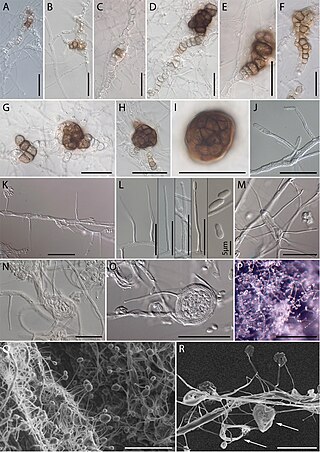
Stachybotrys is a genus of molds, hyphomycetes or asexually reproducing, filamentous fungi, now placed in the family Stachybotryaceae. The genus was erected by August Carl Joseph Corda in 1837. Historically, it was considered closely related to the genus Memnoniella, because the spores are produced in slimy heads rather than in dry chains. Recently, the synonymy of the two genera is generally accepted. Most Stachybotrys species inhabit materials rich in cellulose. The genus has a widespread distribution and contained about 50 species in 2008. There are 88 records of Stachybotrys on Species Fungorum, of which 33 species have DNA sequence data in GenBank. Species in the genus are commonly found in soil, plant litter and air and a few species have been found from damp paper, cotton, linen, cellulose-based building materials water-damaged indoor buildings, and air ducts from both aquatic and terrestrial habitats.
Chrysosporium is a genus of hyaline hyphomycetes fungi in the family Onygenaceae.

Niesslia is a genus of fungi in the family Niessliaceae. It was circumscribed by German mycologist Bernhard Auerswald in 1869, with Niesslia chaetomium assigned as the type species.
Trichocladium is a genus of fungi within the Chaetomiaceae family.

Sporothrix is a ubiquitous genus of soil-dwelling fungus discovered by Schenck in 1898, and studied in more detail by Hektoen and Perkins. The first described and best known species is Sporothrix schenckii, the causative agent of rose handler's disease. New environmental, and pathogenic, species have been discovered with the potential for more to be found as molecular techniques advance.

Cordana is an ascomycete fungus genus. In 2020, it was placed within the monotypic family of Cordanaceae, and within the order Coniochaetales.

Taeniolella is a genus of asexual fungi hyphomycetes in the family Mytilinidiaceae. Some of the species are lichenicolous (lichen-dwelling), others are saprophytic, while others are endophytic. The genus was circumscribed in 1958 by Canadian mycologist Stanley John Hughes, with Taeniolella exilis as the type species. Major revisions of the lichenicolous species in the genus were published in 2016 and 2018.

The Coniochaeta are a genus of pleomorphic yeasts of the order Coniochaetales and are pathogens of trees. Some species have also been found to form endophytic associations within plants in which they live inside plant tissues but do not actually harm the organism. They can take the form of pink to brown colonies, hyphae, conidiophores or sclerotia. In 2013, the Lecythophora were merged with the Coniochaeta, following suggestions by Ziauddin Khan et al.

Exserohilum is a genus of fungi in the family Pleosporaceae. The Exserohilum species are known for causing blight and human immune system diseases. The sexual reproductive states of Exserohilum species are known as Setosphaeria. The type species is Exserohilum turcicum. This genus is among three dematiaceous that are categorized for containing pathogens leading to diseases like phaeohyphomycosis.
Canalisporium is a fungus genus of uncertain placement in the Sordariomycetes. It was placed in order of Savoryellales in 2020.
Gliomastix is a genus of fungi belonging to the family Bionectriaceae.

Rhinocladiella is a genus of fungi in the family Herpotrichiellaceae. It has 17 species. The genus was circumscribed by Swedish botanist John Axel Nannfeldt in 1934 with R. atrovirens as the type species.
Cephalotrichum is a genus of fungi belonging to the family Microascaceae.
Dactylaria is a genus of fungi belonging to an unknown family. According to Wijayawardene et al. 2020; the genus was placed in order Helotiales genera incertae sedis.

Dictyosporium is the type genus of fungi belonging to the family Dictyosporiaceae. By an estimate in 2018 it is formed by 45 species.
Conioscypha is a genus of terrestrial and freshwater fungi in the monotypic family Conioscyphaceae and the monotypic order Conioscyphales. They are found on decayed wood, leaves, or bamboo stems. Except for Conioscypha japonica which was isolated from dog skin fragments and hair in 2017.
Pleurotheciaceae is a family of ascomycetous fungi within the monotypic order of Pleurotheciales in the subclass Savoryellomycetidae and within the class Sordariomycetes.
Pleurothecium is a genus of terrestrial and freshwater fungi in the family Pleurotheciaceae and the monotypic order Pleurotheciales. It is typified by Pleurothecium recurvatum as the type species (Morgan) Höhn, which has the synonym of Carpoligna pleurotheciiF.A. Fernández & Huhndorf, Mycologia 9: 253. 1999.








